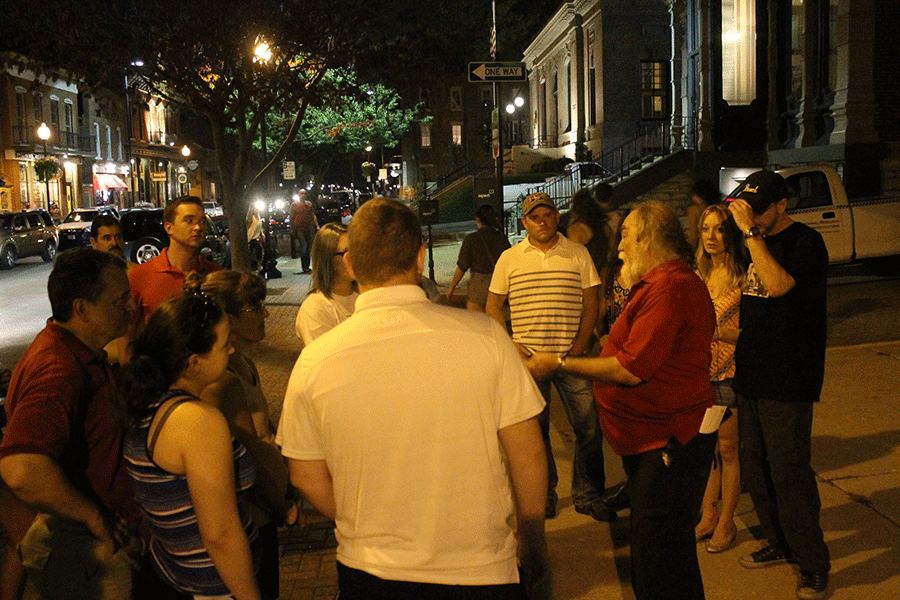The Ghosts Of St. Charles’ Past
Published: September 23, 2015
A group gathers outside The St. Charles County Historical Society building, eagerly awaiting the beginning of Michael Henry’s St. Charles Ghost Tour of Main Street. Henry has been administering the tour every weekend for almost 10 years and has lived in St. Charles for most of his life.
“I always call it an under exploited location,” Henry said. “People don’t realize really cool things have happened here and how old the area is. Going back to Native Americans, there have been people here for at least 3,000 years, probably more.”
The Bloodstain
One of the first stops on the tour is the site of Sheriff Ebenezer Curtis’ suicide. Curtis was called upon to execute two criminals, Charles May and John Taylor. The two men were executed on April 17, 1904, upon the gallows. Curtis, afflicted by the horrific deed, shot himself in his apartment a few months later. Curtis managed to drag himself down the stairs and into the alleyway leading to the apartment before he finally died. His body was found the next morning. In the alleyway, a large bloodstain can still be found over 100 years later, with the aid of an ultraviolet flashlight. The bloodstain remains due to a mixture of chlorine and ammonia used to clean the area after a colony of bats took up residence there.
“The power wash, every time it hits that, it recharges it.” Henry said. “It actually creates a chemical that is very similar to the chemical that is in the butt of a firefly or a glowstick. It’ll be there another hundred years if they continue to clean it up every six or eight weeks.”
Many tour goers found the bloodstain to be very interesting and were amazed the spot could be seen after all this time.
“I thought the most interesting [part of the tour], were those bloodstains on the wall in there,” Camela Perkins, a tour participant, said. “That blood spot was really cool.”
The tour proceeds to the rebuilt Borromeo Church, where the apparition of the Lady in White is frequently seen.
“It’s so dark and kind of off the road,” John Blair, a tour participant, said. “ It’s quiet and secluded. I could see people getting spooked out there.”
The Lady in White
The Church was once a cemetery, but the bodies have since been relocated.
The Lady in White was buried in the former cemetery. The woman’s name and exact location of her grave have been lost to history. A letter written by Hiram Berry to his family in 1822, reveals more about the mysterious apparition. The woman was 23 and had given birth to a baby boy, before she died of what was suspected to be cholera. The woman had been poor, and was buried in her wedding dress- the only outfit she owned fit for a burial.
“This is the second place we find a full manifestation,” Henry said. “Several times a year, people will be standing down at the entrance of the cemetery looking up this way about sunset, and right about here they will see a woman standing in a long white dress, standing quietly, perhaps praying. They approach her, she moves behind the building and can’t be found.”
Lewis and Clark’s Dogs
One of the last stops on the tour is the Blanchette House. At the beginning of the tour, the participants were provided electromagnetic field (EMF) detectors. EMF detectors pick up on changes in electromagnetic energy, a common sign of paranormal activity. Several tour goers had readings on the EMF detectors in the street across from Blanchette House. This is where the manifestation of Lewis and Clark’s dogs is experienced. During their expedition, Lewis and Clark stopped at Blanchette House. Two of their dogs died and were buried somewhere in the area. Workers on Main Street occasionally report hearing dogs playing in the street, or will distinctively smell wet dog.
Most tour goers are believers in the paranormal with previous experiences, although some are skeptics. The tour covers a large amount of St. Charles’ history, making it an interesting event for skeptics and believers alike.
“Have an open mind.” Blair said. “It’s a great historical reference, especially for us not being from here. We got to learn a little bit about the city we live in now.”








![2025 Snowcoming Pep Assembly [Photo Gallery]](https://FHNtoday.com/wp-content/uploads/2025/03/IMG_9969-300x200.jpg)
![2025 Snowcoming Dance [Photo Gallery]](https://FHNtoday.com/wp-content/uploads/2025/03/Snowco2025-Hmartin-3-300x200.jpg)
![Girls Soccer Holds Fourth Day Of Tryouts [Photo Gallery]](https://FHNtoday.com/wp-content/uploads/2025/03/AOrozco_Soccertryouts_3.6-20-300x200.jpg)



